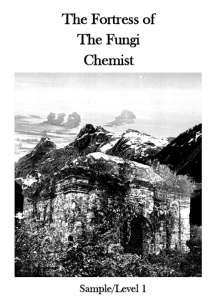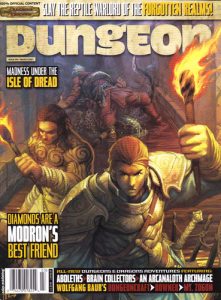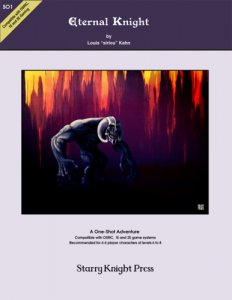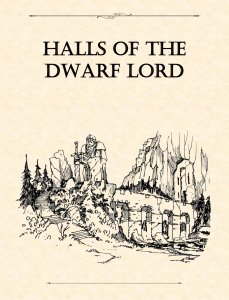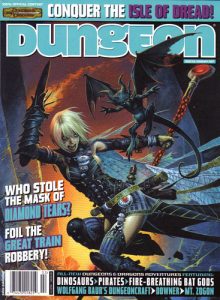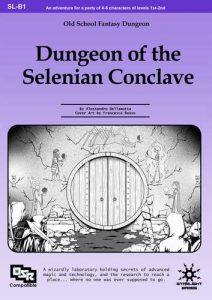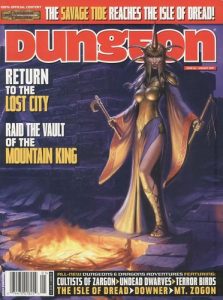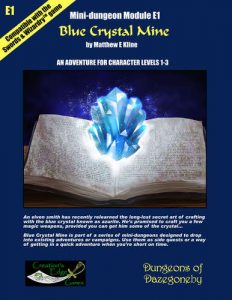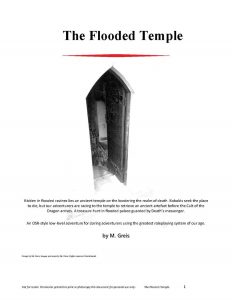By Michael Raston
Lizard Man Diaries blog
Black Hack
Level 1
Lightless, vine-covered and rotting-stone, top level of abandoned dwarf fortress. Beneath vines is ever impressive carved stone, crumbling with damp and vegetation. Barracuda men mostly inhabit flooded western half, jungle dwarfs the east. As highest level of fortress allows views of jungle and of interior cavern.
This is an eight page adventure detailing the first level of a dungeon with thirty six rooms. It’s the first level, a demo level, or a project that is supposed to provide more levels. It’s got A LOT of terse evocative descriptions and is channeling a pseudo-one page dungeon, with one page for the map, one for the “core” room descriptions, two for monster descriptions and one for generic dungeon dressing. There’s a little bit of the “construct your own” of B1 in this. It’s nice, but has some “design in isolation” vibe in it.
Format first. The designer has a vision that is riding the format. ALL of the room descriptions, all 36, fit on one triple-column page, with a little room to spare. This is supported by a page with five or six random tables on it. Random treasure. Random magic items. Random corridor descriptions. Random trap effect. When you need one you roll and that supplements the room description. Likewise, the monster stats all appear on two pages at the end, two monsters to a page. Embedded in them, besides the normal descriptions/stats, are both a reaction table and an Emanations table … signs that the creature was here recently. What this amounts to is five reference sheets. I like reference sheets. I harp on the need for them all the time. This thing has, more than anything I’ve seen including Stonehell, a “reference sheet” mentality. They don’t LOOK like reference sheets, but that’s what they are. It’s a nifty concept. Tape the map to your DM screen and then have two double-sided sheets in front of you, one with the monsters and one with the dungeon. It’s an interesting vision and I think the format works well to enable the DM to easily run the adventure.
The room descriptions, again all 36 fitting on one page, are quite evocative. Just a sentence or two jabbing you like an icepick in the brain to implant a seed. Room one, the stairs in, are: “Great cracked and worn stone stairs, vine and damp covered. A dark maw of an arch, darkness beyond. Stench of corpse wafts.” Or how about this one “Black puddles swarming with larva. Piles of shed barracuda men skins in corners.” Impressions, these are both representative of the writing for the vast majority of the rooms. The designer leverages the DM to take the impression they’ve provided and let their DM brain fill in rest for the players to encounter. It’s exactly the sort of evocative description I’m looking for. A terse quick hit that implants an idea that IMMEDIATELY blossoms in my head and lets me fill in the rest of the details and interactions myself. It’s a good design principle when the writing is evocative, as it is here.
But … I think there’s a problem. The descriptions are terse. They are well written and evocative. But they don’t GO anywhere. They feel isolated from each other. I mean this in a specific way, but I don’t think I know the words to express it. It’s not theming. Certain parts of the dungeon are themed to barracuda men or jungle dwarves or so on. To that extent the rooms, such as the larvae pool example, contribute to the theming of that area. But they don’t seem to work together, or even in isolation, beyond that aspect. The number of rooms where there’s something TO DO is quite small. It feels a little like you’re browsing the World Showcase at Epcot. You can look around, maybe interact with the locals, but there’s not much more beyond that. The interactivity and the relationship of that interactivity between different rooms is missing. I question my thinking on this subject in only one way: this is the first level of a dungeon and I think there’s more room for ‘tourism’ and disconnected stuff in the first level of a dungeon.
This is, I would assert, where the designers formatting vision has let them down. Curtis solved this problem in Stonehell by providing three of pages of additional text to describe how the level and features worked. This allowed him to stick all of the monsters and map on one page and just say “Great Stone Face” … referencing the paragraphs on earlier pages that described how the face worked. I’m just not sure there’s any room to HAVE that interactivity, or relation, between the rooms in the “one page description” format used here. I’m not saying it’s impossible, I just can’t imagine how it would be done. I imagine the same dungeon, but this time instead of the room descriptions being one page they are one sheet, front and back. That would allow for “DM text” that expanded on the interactivity and relationships.
The “general table” page has a table for doors, to describe them, and one for trease and traps. There’s barely enough doors to justify a four-entry door table being separate, and there don’t seem to be more than four traps, making the four-entry trap table superfluous. The mundane treasure and magic item tables are excellent, but again it doesn’t seem like there’s enough of either to justify their existence … unless you are trying to get your entire dungeon listing on to one page.
Speaking of that magic treasure, it’s GREAT. A bronze ring that always sheds ash, you get advantage when testing fire resistance/handling. Removing it in the presence of flames cause sthe flames to whoosh towards it. All of them are light this. A terse description that has something weird/magical, an effect and then also a slight disadvantage. I love them and they are great example of how a magical item can retain its wonder while still providing mechanical effects.
Monsters are all new, with a little portrait, a name, some aliases, a short description that includes temperament, stats, and then the reaction table and the Emanations table. For barracuda men you might find an animal corpse quivering, claw wounds pulsating with fish eggs. Nice! Or one of three other signs that the barracuda men were here recently. That’s a good technique for foreshadowing the monsters and giving the players a nice build up. Good horror never shows the monster straight on, you always get hints first. The reaction tables are different for each monster, with the jungle dwarves being less likely to attack and more likely to talk/interact. Again, a nice way to differentiate the creature with the selected effects, like “Walks slowly backwards to the nearest body of water and submerges, hissing the entire time.” for one of the barracuda men entries. All that’s really missing is a little faction play; how they view their neighbors and so on.
This packs a mighty punch in just eight pages. There’s some mix between tourism and interactivity that works well. You need both. Too much interactivity feels like set-pieceville and too much tourism turns it in to an Ed Greenwood adventure; interesting to look at but going nowhere. I’m open to being wrong, because of the “first level of the megadungeon” issue, but it still feels light to me, constricted by the choices made for formatting.
You can pick it up on blogs webpage. Page four has the room descriptions and page six and seven the monsters.
https://lizardmandiaries.blogspot.com/2017/06/fortress-of-fungi-chemist-level-1.html

